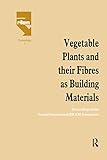Vegetable plants and their fibres as building materials edited by H.S. Sobral
Idioma: Inglés Detalles de publicación: London Chapman and Hall New York Van Nostrand Reinhold 1990Edición: 1a edDescripción: xvii, 374 p il 24 cmISBN:- 041239250X
- International Council for Building Research, Studies and Documentation (CIB) Congress
- International Union of Testing and Research Laboratories for Materials and Structures
- Universidade Federal da Bahia
- 624.1897 V343v 21
| Tipo de ítem | Biblioteca actual | Colección | Signatura topográfica | Copia número | Estado | Fecha de vencimiento | Código de barras | |
|---|---|---|---|---|---|---|---|---|
| Libro Colección General | Central Bogotá Sala General | Colección General | 624.1897 V343v (Navegar estantería(Abre debajo)) | 2 | Disponible | 0000000070292 | ||
| Libro Colección General | Ingeniería Bogotá Sala General | Colección General | 624.1897 V343v (Navegar estantería(Abre debajo)) | 1 | Disponible | 0000000070291 |
Al pie del titulo: Proceedings of the Second International Symposium sponsored by RILEM (The International Union of Testing and Research Laboratories for Materials and Structures) and co-sponsored by CIB (International Council for Building Research Studies and Documentation) and organized by UFB a (Universidade Federal da Bahia, Brazil). Salvador, Bahia, Brazil, september 17-21, 1990
Incluye referencias bibliografías e índice
Parte 1 Introduction and backbround ; parte 2 survey of present situation in relation to fibres ; parte 3 properties of vegetable fibre composite materials ; parte 4 building components whit vegetable fibre composite materials ; parte 5 building components made with wood ; parte 6 building with culms and sticks ; parte 7 recycling of agricultural waste and related topics
In many of parts of the world the use of vegetable plants and their fibres as building materials is vital for low-cost housing and other construction, for reinforcing cement-based and concrete products, for soil stabiization and many other applications. However, great technical ingenuity is needed to develop appropriate fabrication techniques and to overcome some of the inherent problems of the materials, such as their poor durability. This volume brings together a wealth of information and experience on successful applications of plants and fibres. It forms the proceedings of the Second International RILEM Symposium on Vegetable Plants and their Fibres as Building Materials held in Salvador, Bahia, Brazil in september 1990 and follows the first Symposium held in Baghdad, Iraq in 1986. It will be of value to those involved in research and use of indigenous fibre materials and to architects , consultants, government departments and development agencias responsible for building programmes throughout the developing world. The objectives of the Symposium were: To examine the state-of-the-art- in the field of vegetable plants and their fibres as building materials, emphasizing their use, properties, fabrication, new procedures and future developments. To make available research results on new techniques for fibre reinforcement and their use in concrete, stabilized clay and other matrices. To analyse procedures to make vegetable fibres and wood the usual building materials in developing countries

